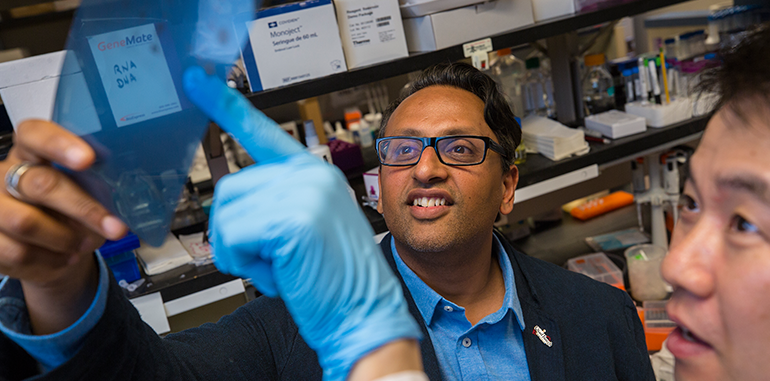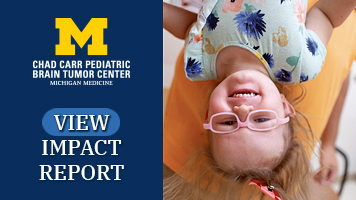
The Chad Carr Pediatric Brain Tumor Center is fueling discovery through innovative research programs on pediatric brain tumors, including DIPG and other high-grade gliomas, and developing distinctive research competences and infrastructure to support groundbreaking clinical trials.
Poised for rapid advances and accelerated translation to clinical practice, our current research is focused on several transformative research areas:
Precision Oncology
Gone are the days of looking for a “one-size-fits-all” treatment for cancer. Precision medicine allows physicians to personalize cancer care based on each patient’s individual genetic profile.
Our precision medicine clinic provides a comprehensive disease-specific case review that incorporates next generation genomic sequencing to identify genetic changes that may be a cause of the tumor’s development. This data is then matched to drugs that target the sequence abnormalities, providing the “precision therapy” individualized for the patient’s cancer. C.S. Mott Children’s Hospital is the first children’s hospital in the country to establish a pediatric precision oncology clinic with prospective, real-time integrative sequencing of pediatric tumors. Our leadership in this area was recognized recently with a groundbreaking publication in the Journal of the American Medical Association (JAMA).
U-M’s comprehensive approach leaves no stone unturned: we’ve expanded sequencing to include deep exome, RNA and germline sequencing, and a 120-gene pharmacogenomics analysis.
More on pediatric brain tumor precision oncology at U-M:
- Decoding cancer: A personalized approach targets genetics
- Precision medicine at the Rogel Cancer Center
- Video: Genetic sequencing for childhood cancer at U-M
Immunotherapy
Immunology is the key to harnessing the power of a patient’s own immune system to target and kill their tumor.
Recent studies suggest that pediatric brain tumors, including DIPG, initiate signals to the immune system that allow the tumors to escape killing. U-M scientists are investigating a number of promising immunologic approaches, including identifying which genetic mutations in DIPG can be targeted in each patient to restore immune function, either alone or in combination with other immunotherapeutic methods.
Our immunologic research is already contributing to the field of cancer immunology, thanks in part thanks to the support of grants from the V Foundation and the ChadTough Foundation.
More on pediatric brain tumor immunotherapy research at U-M:
Tissue Banking
The U-M Brain Tumor Bank includes 100s of pediatric neurological tumor specimens — an enormous resource which has fueled research not only here at U-M but also for national multi-center collaborations.
U-M’s investment and expertise in genetic sequencing of tumor tissues has positioned us as one of the world’s destinations for sophisticated epigenetic analysis.
We are expanding our brain tumor tissue bank to include more and better characterized pediatric brain cancer specimens, with a goal of shedding important light on DIPG and other brain tumors. By expanding and further developing a pediatric brain tumor bank including all types of tumors, we will greatly improve our ability to make important discoveries and progress in uncovering novel treatments for DIPG.
Pediatric Brain Tumor Donation
Cellular Therapy
The use of the patient’s own immune cells to develop cancer-targeted cellular therapies is one of the most innovative approaches under development. U-M is committed to developing advanced effective cellular therapies both for use independently as well as in combination with precision oncology and immune-targeted therapies to treat gliomas and other brain and neural tumors.
More on pediatric brain tumor cellular therapy research at U-M:
- H3K27M Interactome Mapping to Discover Novel DIPG Therapeutic Targets
- Metabolic approaches to combat DIPG
Drug Delivery and Device Development
The rarity of diseases like DIPG has historically been an impediment to commercial drug development in the area of childhood cancer. Drug delivery and the development of new devices are critical components in the search for more effective treatments for pediatric brain tumors.
More on pediatric brain tumor drug delivery and device deployment research at U-M:
Biology and Therapeutics
DIPG arises in the brainstem. Because it envelops the child’s normal brainstem, which contains the nerve fibers that control vital functions of the head, heart and lungs, the tumor cannot be removed surgically, and the standard of care remains radiation therapy. One reason scientists haven’t made significant advances in treatment is because there haven’t been good models of the disease, which can provide the biological understandings needed to develop new treatments.
U-M scientists have begun development of the first genetically engineered model of DIPG. Our labs are also working on developing a high-grade glioma model which uses patient-derived cells, and studying the molecular information from patients’ tumors to design targeted treatments.
Clinical Trials
Clinical trials are the mechanism through which scientists and physicians test the newest, most promising treatment advances to determine their effectiveness.
Building on the outstanding success of our pediatric phase 1 trial portfolio, we are aggressively expanding our pediatric brain tumor clinical trial offerings.
More on clinical trials:



